
The Man Who Farms Water and the Rainwater-Harvesting Guidelines
We forget that the water cycle and the life cycle are one.
—Jacques Cousteau
This chapter is the core of the book and the heart of successful water harvesting. It describes eight guiding principles and three overriding ethics that are the foundation of how to conceptualize, design, and build integrated water-harvesting systems that generate multiple benefits. Use the principles and ethics as an integrated system, while thinking of them as a supportive mantra you can chant or a guiding song you can hum as you play in the rain and experiment with water harvesting.
Used together, these principles and ethics will greatly increase your chance of success, dramatically reduce mistakes, empower you to adapt various strategies to meet your site’s specific needs, and allow you to expand the benefits of your work well beyond your site. Learn from doing, but don’t go into it blind.
I begin with a story of the man whose life embodies the power of water harvesting, and who made it all click for me. …
THE MAN WHO FARMS RAINWATER
While traveling through southern Africa in the summer of 1995, I heard of a man who was farming water. I set out to find him and soon was packed into a colorful old bus roaring through the countryside of southern Zimbabwe. The scenery was beautiful, with rolling hills of yellow grass on red earth and small thickets of twisting, umbrella-like trees. Nine hours later we arrived in Zimbabwe’s driest region. We crested a pass of low-lying semi-desert vegetation. Below us spread a vast veldt prairie of undulating hills covered with dry grass and capped with barren outcroppings of granite. Trees were sparse. All was covered by a wonderful expanse of clear blue sky, reminding me of the open grasslands of southeastern Arizona. The bus crept down and stopped in Zvishavane, the small rural town where the water farmer lived.
In the morning, I hitched a ride with the local director of CARE International. She took me to a row of single-story houses. One of these was the simple office of the Zvishavane Water Project. There on the porch sat the water farmer, reading a Bible.
As my ride came to a stop he sprung up with a huge smile and warm greetings. Here at last was Mr. Zephaniah Phiri Maseko. When he learned how far I had traveled, he burst into a wonderful laugh. He told me that lately visitors from all over the globe seemed to be dropping in once a week. Nonetheless, for him each was an unexpected surprise. Mr. Phiri jumped into the vehicle and we drove off over worn, eroded dirt roads toward his farm. An endless stream of poetic analogies, laughter, and stories began to pour from his mouth. The best story of all was his own.
In 1964, he was fired from his job on the railway for being politically active against the white-minorityled Rhodesian government. The government told him that he would never work again. Having to support a family of eight, Mr. Phiri turned to the only two things he had—an overgrazed and eroding 7.4-acre (3-hectare) family landholding, and the Bible. He used the Bible as a gardening manual and it inspired his future. Reading Genesis he saw that everything Adam and Eve needed was provided by the Garden of Eden. “So,” thought Mr. Phiri, “I must create my own Garden of Eden.” Yet he also realized that Adam and Eve had the Tigris and Euphrates Rivers in their region, while he didn’t have even an ephemeral creek. “So,” he thought, “I must also create my own rivers.” He and his family have done both.
The family farm is on the north-northeast-facing slope of a hill providing good winter sun to the site since it is in the Southern Hemisphere. The top of the hill is a large exposed granite dome from which stormwater runoff once freely and erosively flowed. The average annual rainfall is about 22 inches (559 mm). However, as Mr. Phiri points out, this average is based on extremes. Many years are drought years when the land is lucky to receive 12 inches (305 mm) of rain. When Mr. Phiri began, it was very difficult to grow crops successfully, let alone make a profit. There were frequent droughts and he had no money for deep wells, pumps, fuel, and other equipment needed for irrigating with groundwater.
Along with everyone else in the area, Mr. Phiri was dependent on the rains for water. Storms always brought him outside to observe how water flowed across his land. He noticed that soil moisture would linger longer in small depressions and upslope of rocks and plants, than in areas where sheet flow went unchecked (fig. 1.1). He realized he could mimic and enhance areas of his land where this was occurring, and he did so. He then spent ample time watching the effects of his work. Thus began his self-education and work in rainwater harvesting—his “water farming.” Over the next 30 years, he created a sustainable system that now provides all his water needs from rainfall alone (fig. 1.2).
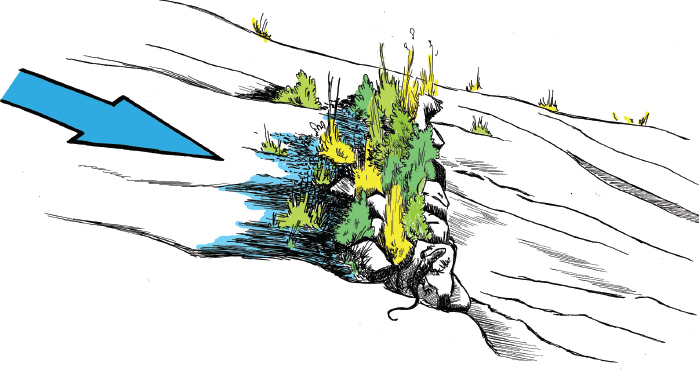
Fig. 1.1. More water, soil, seeds, and life gather where their flow across the land is slowed (here by rocks on contour).
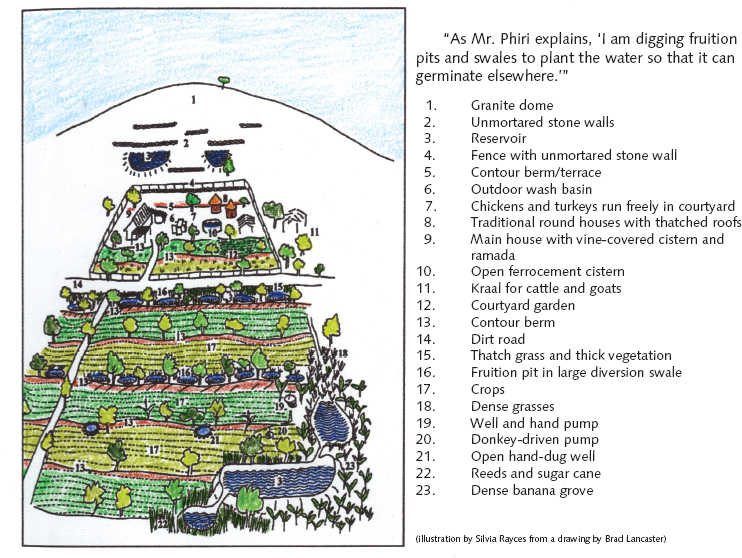
Fig. 1.2. Layout of Mr. Phiri’s farm
“You start catchment upstream and heal the young, before the old deep gullies downstream,” says Mr. Phiri. Beginning at the top of the watershed, he built unmortared stone walls at random intervals on contour (along lines of equal elevation). These “check dam walls” slow or “check” the flow of storm runoff and disperse the water as it moves through winding paths between the stones. Runoff is then more easily managed because it never gets a chance to build up to more destructive volumes and velocities. Controlled runoff from the granite dome is then directed to unlined reservoirs just below.
These reservoirs were built with nothing more than hand tools and the sweat of Mr. Phiri and his family. All work on the land was—and is—done on the human scale, so that it can be maintained on the human scale.
The larger of the two reservoirs Mr. Phiri calls his “immigration center.” “It is here that I welcome the water to my farm and then direct it to where it will live in the soil,” he laughs. The water is directed into the soil as quickly as possible. The reservoirs are located at the highest point in the landscape where soil begins to cover the granite bedrock. (See figure 1.3.)
Fig. 1.3. Mr. Phiri in his “immigration center” reservoir
Above the reservoirs the slope is steep with little soil. At and below the reservoir, the slope is gentle and soil has accumulated. “The soil,” Mr. Phiri explains, “is like a tin. The tin should hold all water. Gullies and erosion are like holes in the tin that allow water and organic matter to escape. These must be plugged.”
Mr. Phiri’s “immigration center” is also a water gauge, for he knows that if it fills three times in a season, enough rain will have infiltrated the soil of his farm to support the bulk of his vegetation for two years. The reservoirs occasionally fill with sand carried in the runoff water. The sand is then used for mixing concrete, or for reinforcing the mass of the reservoir wall. Gravity brings this resource to Mr. Phiri free of charge.
Overflow from the smaller reservoir is directed via a short pipe to an aboveground ferrocement (steel-reinforced concrete) cistern that feeds the family’s courtyard garden in dry spells. The family has another cistern, shaded and cooled by a lush food-producing passion vine (fig. 1.4). This cistern collects water from the roof of the house for potable use inside. Aside from these two cisterns, all water-harvesting structures on the farm directly infiltrate water into the soil where the water-harvesting potential is the greatest. All greywater (used wash water) from an outdoor washbasin is drained to a covered, unmortared, stone-lined, shallow, underground cistern where the water is quickly percolated into the soil and made available to the roots of surrounding plants.
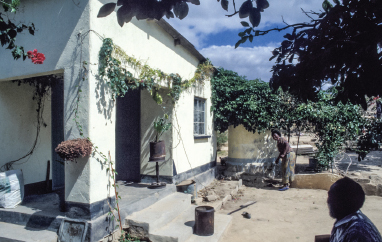
Fig. 1.4. The family house, courtyard, cistern, and passion vine
Across the farm’s entire watershed from top to bottom, numerous water-harvesting structures act as nets that collect the flow of surface runoff and quickly infiltrate the water into the soil before it can evaporate. These include check dams (small unmortared stone structures placed within drainages perpendicular to the water’s flow; see figure 1.5), vegetation planted on contour, terraces, berm ’n basins (dug out basins and earthen or vegetated berms laid out on contour), and infiltration basins (basins without berms). All these catch water that was once lost to a government-built drainage system.
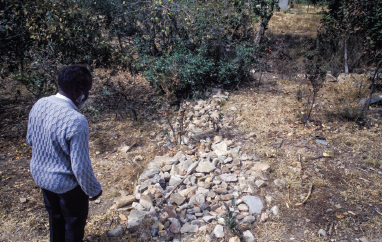
Fig. 1.5. A loose-rock check dam that has healed a once-erosive gully
Many years before, the government had built large drainage swales throughout the region. Unlike most water-harvesting swales or berm ’n basins, these ditches were not placed across the slopes on contour (to retain water), but instead were built so they’d drain water off the land. Vast amounts of unhindered monsoon runoff were caught by the drainage swale, carried away to a central drainage, and shot out to the distant floodplain. The erosion problem was decreased, but drought intensified because this area was being robbed of its sole source of water.
Mr. Phiri turned things around by digging a series of large “fruition pits” (basins about 12 feet long by 3 to 6 feet wide by 4 to 6 feet deep) in the bottoms of all the drainage swales on his land. Now when it rains the pits fill with water and the overflow successively fills one pit after another across his property. Long after rains stop, water remains in the fruition pits percolating into the soil. “You see,” giggled Mr. Phiri, “my fruition pits are very fruitful.” The fruit of the fruition pits takes the form of thatch grasses, fruit trees, and timber trees, which are planted in and around the pits. This vegetation provides building materials, cash crops, food, erosion control, shade, and windbreaks, all watered strictly by rain and the rising groundwater table underground. As Mr. Phiri explains, “I am digging fruition pits and swales to ‘plant’ the water so that it can germinate elsewhere.” (See figure 1.6.)
Fig. 1.6. Sketch of Mr. Phiri standing in a fruition pit full of thatch grass
“I have then taught the trees my system,” continues Mr. Phiri. “They understand it and my language. I put them here and tell them, ‘Look, the water is there. Now, go and get it.’” A basin for holding water may be constructed around or beside the trees, but such earthworks are also placed further out from the trees so their roots are encouraged to stretch out and find still more water.
A diverse mix of open-pollinated crops such as basketry reeds, squash, corn, peppers, eggplant, tomatoes, lettuce, spinach, peas, garlic, onion, beans, passion fruit, mango, guava, and paw paws, along with such indigenous crops and trees as matobve, muchakata, munyii, and mutamba, are planted between the swales and contour berms. This diversity gives his family food security; if some crops fail due to drought, disease, or pests, others will survive. Rather than using hybrid and genetically modified (GMO) seed, Mr. Phiri uses open-pollinated varieties to create superior seed stock as he collects, selects, and plants seed grown in his garden from one year to the next. By propagating seed from plants that have prospered off the sporadic rainfall and unique growing conditions of his site, each season his seed becomes better suited to his land and climate. This seed saving is another form of water conservation, because Mr. Phiri adapts his seed to live off less water, instead of adapting his farm management to import more water.
Living fertilizer factories pepper the farm in the form of nitrogen-fixing plants. One example, the edible, leguminous pigeon pea, is also used for animal fodder and mulch. Mr. Phiri has found that soils amended with local organic matter and nitrogen-fixing plants infiltrate and hold water much better than those amended with synthetic fertilizers. As he says, “You apply fertilizer one year but not the next, and the plants die. Apply manure once and plant nitrogen-fixing plants, and the plants continue to do well year after year. Synthetically fertilized soil is bitter.”
The abundant food and fruit Mr. Phiri produces is anything but bitter. He’s been generous with his abundance, giving away a diverse array of trees to anyone who wants them. Unfortunately, as Mr. Phiri points out, the majority of the trees he gives away die when people don’t implement rainwater-harvesting techniques before planting. “The land must harvest water to give to the trees, so before you plant trees you must plant water.” Mr. Phiri propagates his trees in old rice and grain bags near one of three hand-dug wells near the bottom of his property (fig. 1.7).

Fig. 1.7. Mr. Phiri’s tree nursery under the shelter of a mature tree
The soil is Mr. Phiri’s catchment tank, and it is vast. In times of drought, his distant neighbors’ wells go dry, even those that are deeper than Mr. Phiri’s. Yet as Mr. Phiri says, “My wells always have water into which I can dip my fingers.” This is due both to the particular hydrologic/geologic conditions of his site and because he is putting far more water into the soil than he takes out.
Except for one well, which is lined and has a hand pump for household water use, all are open and lined with unmortared stone. “These wells,” explains Mr. Phiri, “are those of an unselfish man. The water comes and goes as it pleases, for you see, in my land it is everywhere.” During severe drought, Mr. Phiri uses a donkey-driven pump to draw from these wells to water annual crops in nearby fields (fig. 1.8).
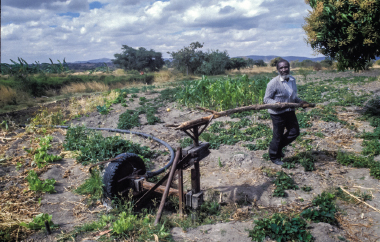
Fig. 1.8. Mr. Phiri demonstrates how a donkey would power the pump in his lower fields.
A lush wetland lies below the wells at the lowest point of Mr. Phiri’s property. Here, three aquaculture reservoirs are surrounded by a vibrant soil-stabilizing grove of bananas (fig. 1.9), sugarcane, reeds, and grasses. The fish are harvested for food and their manure enriches the water used to irrigate the vegetation. The taller vegetation creates a windbreak around the ponds, reducing water loss to evaporation. The dense, lower-growing grasses filter incoming runoff water, as well as feed his cows when in calf. (See figure 1.10 of the largest reservoir.)
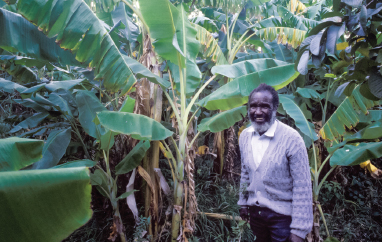
Fig. 1.9. Mr. Phiri in his banana grove
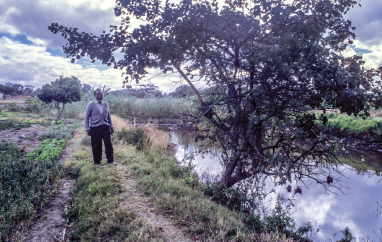
Fig. 1.10. Mr. Phiri beside his largest aquaculture reservoir
Mr. Phiri has created his Garden of Eden. The rain infiltrates his soil; the reservoirs and vegetation are where it “surfaces.” This harvested rain creates the “rivers” of infiltrated moisture his Garden needed to succeed. After 30 years of work his farm continues to grow, and his methods are now starting to be appreciated.
For years Mr. Phiri was the object of scorn since he found himself in opposition to international aid and government programs that pushed groundwater extraction and export crops over rainwater harvesting and local food production and distribution. As a response Mr. Phiri created the Zvishavane Water Project, a nongovernmental organization that is spreading his techniques well beyond his site (see box 1.1). It is having a dramatic effect. He influenced CARE International in his region to the point that it shifted much of its work from giving away imported food, to helping people implement Mr. Phiri’s methods of planting the rain and growing their own food.
Box 1.1. Zvishavane Water Project
While the Zvishavane Water Project is in transition, check out the Muonde Trust (Muonde.org) for great works inspired by Mr. Phiri and other indigenous innovators.
For more on Mr. Phiri see the book The Water Harvester—Episodes from the Inspired Life of Zephaniah Phiri by Mary Witoshynsky.
When I asked Mr. Phiri about the three decades it took him to get his land and his vision to where it is today he answered, “It’s a slow process, but that’s life. Slowly implement these projects, and as you begin to rhyme with nature, soon other lives will start to rhyme with yours.”
We then walked back up toward the house and stopped midway. Mr. Phiri’s eyes were full of excitement and joy as he pointed across the fence. His neighbor was in the government’s diversion swale, digging fruition pits on the adjoining property. “Look,” cried Mr. Phiri, “he is starting to rhyme!”
My visit with Mr. Phiri made clear to me that we all have the choice and power to be either the problem or the solution. He told me of a local school where the teachers were striking and threatening to leave due to lack of water and harsh conditions in dusty, hot, wind-blown classrooms. Students were in no condition to learn, being malnourished without school meals and with little food at home. Mr. Phiri listened to the complaints of the teachers then asked them not to run from their problems. He told the teachers, “to look upon wherever they found themselves as home, to set their roots into the ground, and to work to nourish and improve their lives together.” Mr. Phiri then made them an offer: If they would stay he would teach them and their students how to turn things around by harvesting the rainfall to grow food, shelter, and beauty. He also warned that if the teachers ran from the situation, they would take their problems with them. Half did leave. The other half stayed, set their roots, and worked with Mr. Phiri and the students. Together they turned the bleak school grounds into lush gardens where lunches are grown on-site and vegetation passively cools buildings and blocks the wind. There is no longer reason to strike or leave, but reason to celebrate.
Years later some of the teachers who left returned. With tears in their eyes they thanked Mr. Phiri for being a man of his word. They also told him his prediction had come true. They had moved on to schools in new settlements in lush lands, but within a few years they had so misused and degraded the land that conditions became as bad as those from which they had run. Mr. Phiri responded by repeating his original offer. The teachers could go back to the schools in the new settlements and heal the scars.
Mr. Phiri turned to me with a huge smile and said, “Remember, children are our flowers; give them rain and they will grow and bloom.”
Box 1.2. Rainwater-Harvesting Principles
1. Begin with long and thoughtful observation.
2. Start at the top—or highpoint—of your watershed and work your way down.
3. Start small and simple.
4. Spread and infiltrate the flow of water.
5. Always plan for an overflow route, and manage that overflow water as a resource.
6. Maximize living and organic groundcover.
7. Maximize beneficial relationships and efficiency by “stacking functions.”
8. Continually reassess your system: the “feedback loop.”
Principles 2, 4, 5, and 6 are based on those developed and promoted by PELUM—the Participatory Ecological Land-Use Management association of east and southern Africa. Principles 1, 3, 7, and 8 are based on my own experiences and the insights gained from Mr. Zephaniah Phiri Maseko and other water harvesters.
EIGHT RAINWATER-HARVESTING PRINCIPLES
Mr. Phiri’s story is a wonderful example of a successful, integrated rainwater-harvesting system (see chapter 5 for an urban example—that of my brother and myself). Keep in mind that the specific techniques used on his site are not applicable everywhere. There is no one standardized design for rainwater harvesting. Every piece of land, the plants and animals upon it, and those who steward it, are unique. Each site must be approached with its own distinctive characteristics in mind. However, there are eight rainwater-harvesting principles that are applicable to all sites, and should always be followed. Each is valuable on its own, but you get the full benefit only if all are used together.
RAINWATER-HARVESTING PRINCIPLE ONE
Begin with Long and Thoughtful Observation
Mr. Phiri was not taught by experts or at schools. He learned from long and thoughtful observation of his land (fig. 1.11)—something everyone can do. When he began, his land was dry, eroded, and unproductive, but he was attentive to, and mimicked, the aspects of his land that were working—including rocks and plants found in informal “rows” perpendicular to the slope where they slowed the rainwater and infiltrated it into the soil. Mr. Phiri mimicked this by tucking his water-harvesting structures perpendicular to the slope around existing vegetation, placed at locations where they suited the needs of his family and land. He then spent ample time watching the effects of his work. As Mr. Phiri says, “I enjoy harvesting water. Really, you know, when the rains fall and I see water running, I am running! Sometimes you will find me being very wet!”
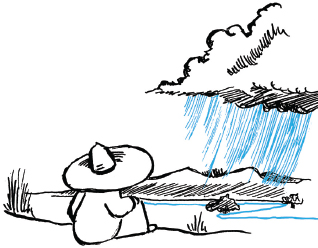
Fig. 1.11. Long and thoughtful observation
To observe your site, sit in the dust and dance in the rain, through all the seasons. Sit down, sit quietly, and turn yourself into a sponge. Listen with all your senses—sight, smell, touch, hearing, taste, and your feelings.
Observe all that is happening. Are there lush green areas where moisture naturally collects? Do you see bare spots where water and soil drain away? Is there running water? Is it polluted? If so, by what? Do trees grow straight, or are they bent—perhaps by strong prevailing winds? Is the soil underfoot washed-out and hard-packed, or soft with accumulated organic matter? Can you hear the songs of birds and insects? Some, such as house finches and dragonflies, are never far from water. Where is the life? The resources? The erosion? Where is water coming from? Where is it going? How much water is here?
Relax and be aware. After you’ve taken plenty of time to observe, contemplate why things are as they are. Why is there erosion? Why does this plant grow here? Why is there more moisture there?
Try to understand the site as a whole, not as separate pieces. Imagine what would happen if you changed something. How would that alter the dynamics of the site’s water flow, wildlife paths, prevailing winds, and solar exposure? How would things improve? How would they get worse?
If you listen, the land will tell you things you need to know, and what you need to investigate more deeply. Devoting time to observation and posing and answering questions are a good ways to get to know PLACE.
Once you connect to a place, it begins to show you its resources and challenges and helps guide your plans. Without understanding your site, you might install water-harvesting earthworks and plant fruit trees in an exposed, wind-dried area far from home where runoff is lacking and fruit-eating wildlife abounds. With better site understanding, you would locate these water-harvesting earthworks and trees where ample runoff, shelter from afternoon sun and prevailing winds, and a greywater-producing home are nearby, resulting in far more productive trees conveniently located for easy picking by people and less fruit-eating by wildlife. The outcome is determined by how well you understand your site, and how well you put things together.
It costs nothing to observe, think, and plan. You could pay dearly in the long run if you don’t. Try to make your mistakes in your head or on paper before doing anything on the land. Keep imagining different scenarios until you settle on the one you consider best.
Box 1.3. Understanding Erosion and Water Flow Patterns
Erosion patterns, the presence of vegetation and wildlife, the size of deposited sediment, the smoothness of rocks, and other patterns give clues to how fast rainfall runoff flows through otherwise dry areas, how much water flows there, where it pools and where it moves. Appendix 1 delves into this more deeply.
Box 1.4. Additional Resources for Learning About Your Land
• Begin measuring and recording rainfall and other site-specific conditions.
• Talk to neighbors about their observations through the years.
• Seek out photos and writings at local historical societies.
• Obtain aerial photos from Google Earth, government mapping departments, and private companies, or hire a small plane to fly you over your site and take photos. This gives you different perspectives of your site and surrounding areas, and documents land changes over time.
RAINWATER-HARVESTING PRINCIPLE TWO
Start at the Top—or Highpoint—of Your Watershed and Work Your Way Down1
When you’re feeling ready to create water-harvesting structures on your land, start at the “top”—or highest elevation—of your on-site watershed (fig. 1.12). You could also state this rule as “start at the beginning”—the beginning of the water’s flow over your buildings and land.
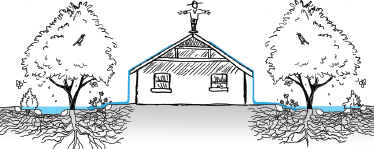
Fig. 1.12. Start at the top.
To begin with, form a mental image of your watershed. A watershed, or catchment area as it is sometimes called, is the total area of a landscape draining or contributing water to a particular site or drainage. The watershed for an erosive rill cut on a bare slope might be no more than 20 square feet (1.9 m2). The watershed for a river may be millions of acres or hectares covering mountains, hills, valleys, mesas, and drainages. Such large watersheds are made up of many small “subwatersheds.” These subwatersheds are a patchwork quilt of small areas of land and buildings, often on the scale of a residential lot, a small parking lot, a commercial site, or a field. You will most likely be focused on the subwatersheds that comprise your home and workplace. These subwatersheds directly affect the larger community watershed, and if they are well managed have the potential to enhance the community watershed! Once you’ve identified the subwatershed of your site, you can begin to practice the art of waterspread, emphasizing the gentle harvesting, spreading, and infiltrating of water throughout a watershed rather than the rapid shedding or draining of water out of it.
Next, consider runoff. When more rain falls than surfaces can absorb, water pools and then begins to flow over roofs, roads, and soils on its way downslope. This surface flow of water is called runoff: water running off the land. Generally, the further you are downslope the greater the runoff volume will have accumulated. The steeper the slope the greater the speed of water you’ll have to deal with. Our goal is to turn this runoff into soak-in: water that no longer runs off the land, but infiltrates into the soil instead.
You may or may not have access to lands upslope of your property line, so begin water harvesting at the top of your “watershed of influence”—basically the sub-watershed composed of the area where you have the greatest say. This could mean a hilltop, the highpoint of your property line, the top of a cooperative uphillneighbor’s land, or the roof of your house.
If you begin to harvest water high in the watershed and work your way down, you’ll make everything easier in the long run because:
• The volume of runoff you will be dealing with at any one time will be less than if you started lower in the watershed, and will be less likely to get out of control and become destructive. As a result, you can manage it better and construct a water-harvesting system in which most of the water will infiltrate before it runs off the land.
• You can use many modest-sized water-harvesting structures, each retaining an easily managed volume of water. Vegetation in modest-sized water-harvesting structures will get watered without getting flooded.
• The rain will infiltrate more evenly into the soil throughout the landscape, not just at the bottom.
• Water you harvest high in the watershed can be moved around the site more easily than water harvested low in the watershed. Gravity is a free and ever-present energy source that does not break down; use it to your advantage.
RAINWATER-HARVESTING PRINCIPLE THREE
Start Small and Simple
Small is beautiful, and perhaps more importantly when it comes to water harvesting, it is less expensive, easier, and more effective than starting big. Mr. Phiri and his family built everything by hand, spent almost nothing on materials, and did all the maintenance themselves. They could do this because everything was done on a human scale, and kept technically and mechanically simple to reduce the need for maintenance, and enable them to do that maintenance. (See figure 1.13.)
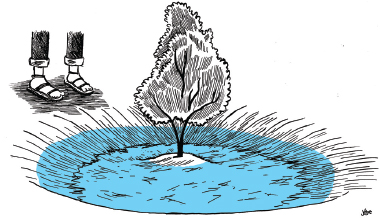
Fig. 1.13. Start small and simple, perhaps by planting a low-water-use native shade tree in a water-harvesting basin to shade the east or west side of your home. Direct roof runoff to the basin to increase water harvested and shade grown.
Small-scale trials of various techniques will quickly show you what works and what doesn’t work on your unique site. You’ll avoid large-scale mistakes. If a small-scale mistake is made, it will teach you, not break you. Starting small lets you and your friends do the work at your own pace, though of course you can hire folks to help with the work. Either way, don’t start by creating an expensive and elaborate system that might not be right for your landscape, lifestyle, and means. Keep in mind that dozens, hundreds, or even thousands of tiny water harvesting “sponges” are usually far easier to create and far more effective than one big dam, because they capture more water and spread it more evenly throughout the land.
RAINWATER-HARVESTING PRINCIPLE FOUR
Spread and Infiltrate the Flow of Water2
Spread out the flow of water so it can slow down and infiltrate into the soil. Make water stroll, not run, through the landscape. This is the act of “waterspread” within the watershed.
Aside from one cistern holding water for a courtyard garden and another capturing roof runoff for household potable water, all Mr. Phiri’s water-harvesting strategies direct the rain into the soil. He uses multiple techniques to spread harvested water over as much porous surface area as possible to give the water maximum potential to infiltrate into his land. Once it has infiltrated, water gently travels through the soil, not destructively over it. As he says, “I plant water as I plant crops. So this farm is not just a grain plantation. It is really a water plantation.”
In contrast, channelization can be compared to a shotgun barrel for water; it typically straightens and constricts water flow by sealing and smoothing the banks and sometimes the bed of a waterway, often with concrete. It’s like the hardening of arteries in the body, and it’s bad for the health of the system. Channelization increases the velocity of water flow through and downstream of the channelized area, reducing infiltration of water into the soil and sometimes deepening the channel.
A culvert (large pipe) placed in a drainage typically forces water flow through a smaller diameter orifice than the full width and depth of the natural drainage. In a large rain event, water backs up on the upstream side of the culvert, builds up pressure, and speeds through the culvert like it was the barrel of a shotgun. Resulting erosion can often be seen just downstream of the culverts. (See figure 1.14.) Yet, we can reduce erosion and enrich the landscape if we slow down the flow of water, spread it out, and allow it to infiltrate. In the second volume of Rainwater Harvesting for Drylands and Beyond, the chapter on in-channel strategies provides examples in drainages.
Fig. 1.14. Culvert acting as an erosive shotgun barrel. Note the undercut bed of the drainageway on the downstream side.
Box 1.5. Small Dams Yield More Water Than Large Dams
A study by the Central Soil and Water Conservation Research and Training Institute in Dehra Dun, India, found that increasing the size of a dam’s catchment from 2.47 acres (1 ha) to about 4.94 acres (2 ha) reduces water yield per hectare by as much as 20 percent.3 As the Centre for Science and the Environment states, “In a drought-prone area where water is scarce, 10 tiny dams with a catchment of 1 ha each will collect much more water than one larger dam with a catchment of 10 ha.”4 The tiny dams don’t need costly water distribution systems either, as they are already located throughout a watershed. Also, small dams displace far fewer people and cause less environmental damage than large dams.
In another example, tiny “dams” yield even more water than small dams. While studying 4,000 year old water-harvesting strategies in the Negev Desert, which enabled ancient people to provide food and water with a scant 4 inches (105 mm) of annual rainfall, Israeli scientist Michael Evenari found that small watersheds harvest far more water than large watersheds.
Summarizing Evenari’s findings, the book Making Water Everybody’s Business states, “While a 1 hectare watershed in the Negev yielded as much as 95 cubic meters of water per hectare per year, a 345 ha watershed yielded only 24 cubic meters of water/ha/year. In other words, as much as 75% of the water that could be collected [in the larger watershed] was lost [to evaporation and the soil].”5 The loss was even higher during a drought year. According to Evenari “…during drought years with less than 2 inches (50 mm) of rainfall, watersheds larger than 123.5 acres (50 ha) will not produce any appreciable water yield, while small natural watersheds will yield 4,400–8,800 gallons (20–40 cubic meters) per hectare, and microcatchments smaller than 0.24 of an acre (0.1 hectare) [will yield] as much as 17,597–21,997 gallons (80–100 cubic meters) per hectare.”6
Figures 1.15A and 1.15B illustrate how a landscape can act as either a drain or a net, respectively. Water flows from the highest point or source of a watershed, to the bottom of the watershed or sink where the water and other resources leave the land for good (see figure 1.16 for Source/Sink).
Fig. 1.15A. A bare landscape acting as a drain. The water’s Source (beginning of its flow) is at the top; its Sink (departure or end of water flow) is at a lower elevation.
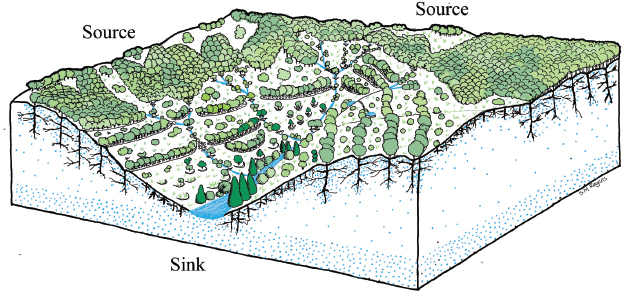
Fig. 1.15B. The same landscape with “nets” of vegetation and water-harvesting earthworks slowing and infiltrating the water
Fig. 1.16A. Source and Sink. A fairly quick and linear downward flow drains the landscape.
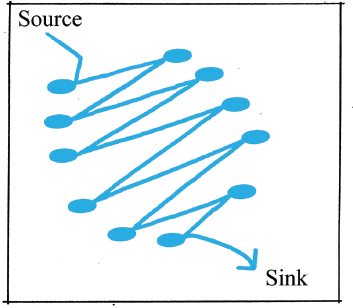
Fig. 1.16B. Source and Sink. The zig-zag increases the time of flow, distance traveled, and ground infiltration from Source to Sink.
The “drain” example of figure 1.15A shows water, soil, and organic matter quickly draining out of the system causing erosion and downstream flooding. Upstream areas are left dry while downstream areas require expensive stormwater management. The system degenerates—or breaks down—over time.
The “net” example (fig. 1.15B) shows the same area with the landscape altered to capture, slow, and spread the flow of water, soil, and organic matter, over and through the entire landscape. This reduces erosion, flooding, drought, and monetary costs of storm drain infrastructure while improving soil fertility, water infiltration, vegetative production, and ecosystem stability—by growing shade, food, shelter, wildlife habitat, and erosion control. This system starts to regenerate— or build and take care of itself.
The goal in water harvesting is to create a series of “nets” across our watershed. Like Mr. Phiri, we should direct runoff into the soil by spreading and sinking its flow. Still, there will always be storms so big that more water will flow across the site than the land or tanks can retain, leading us to the next principle.
RAINWATER-HARVESTING PRINCIPLE FIVE
Always Plan for an Overflow Route, and Manage That Overflow Water as Resource7
Overflow should not be treated as a problem or a waste. Instead, design the overflow route so that surplus water becomes a resource (fig. 1.17). Mr. Phiri converted the government-built drainage swales cut across his land into a water-harvesting project by digging “fruition pits”—or stepped infiltration basins— within the bottom of the large swales. Any excess water overflows from one fruition pit to the next and ultimately drains away down the big swales. All of Mr. Phiri’s water-harvesting structures have planned overflow routes. In huge storms extra runoff is directed from one harvesting structure to the next until it reaches the bottom of his site where it is released onto the natural floodplain below.
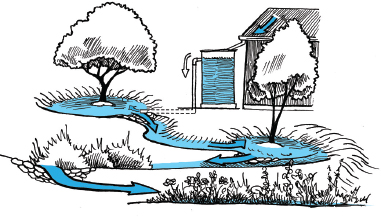
Fig. 1.17. Cistern overflow water directed to, filling, and then overflowing one earthwork to fill another and another
No matter how well you design your system always plan for overflow in very large storm events. Overflow spillways should be stabilized using heavy tightly packed rock, or well-rooted vegetation so they hold up to large flows. Overflow from tanks and cisterns must be safely routed out of the tank and away from the tank’s foundation. Overflow should be directed to a useful location such as a vegetated infiltration basin that passively irrigates a native shade tree that in turn shades the tank, provides food, and creates wildlife habitat. The need to manage overflow applies to all cisterns and water-harvesting earthworks. As the Boy Scouts say, “Be Prepared.” Make sure that when your system overflows, it overflows where you want it to, and in a controlled manner.
Be sure your site has a final overflow outlet at the bottom of your watershed. Ideally this would direct water into a natural vegetated wash or creek, but in the urban environment you may have to settle for a street or storm drain.
RAINWATER-HARVESTING PRINCIPLE SIX
Maximize Living and Organic Groundcover8
Rather than infiltrating, water often flows off flat or mounded bare dirt surfaces, or pools for days inside bowl-shaped surfaces and evaporates or supports mosquito breeding. This is because bare dirt is prone to compaction and the surface tends to seal up, both conditions which reduce the ability of rainwater to infiltrate below the surface. In contrast, covering dirt with organic groundcover such as mulch and plantings increases infiltration into the soil. Growing plants set down roots and drop leaves to generate mulch. Earthworms and other soil life convert the leaf drop into more soil, riddled with their holes. I’ve found the roots of these plants, coupled with surface mulch and the associated soil life, grow to create a living sponge that can more than double stormwater infiltration rates in previously bare basins, reducing evaporation, runoff, erosion, and mosquito breeding! (See figure 1.18.)
Fig. 1.18. Planting vegetative groundcover, spreading organic mulch, and planting seed to help permeate, protect, and build soil with roots, leafy cover, mulch, and accumulating leaf drop
Mr. Phiri’s site is a living vegetation-covered welcome mat that helps water infiltrate into the soil and pumps soil moisture back to the surface through roots. The vegetation literally brings harvested water to “fruition,” transforming it into fruits, vegetables, and grains for people and livestock, hot afternoon shade for home and fields; a dense mat of roots and leaves to stabilize spillways and control erosion; lumber and thatch for building; fiber for clothes; medicinal herbs; and leaf drop that breaks down and fertilizes the soil.
Native vegetation—indigenous plants found within 25 miles (40 km) of your site and within an elevation range of 500 feet (152 m) above or below your site— is generally best adapted to local rainfall patterns and growing conditions, and these plants often make great groundcovers.
RAINWATER-HARVESTING PRINCIPLE SEVEN
Maximize Beneficial Relationships and Efficiency by “Stacking Functions”
Mr. Phiri looks well beyond water infiltration and strives to improve his whole site, not just one aspect of it. He does this by designing and placing his water-harvesting structures in relationship to the overall landscape so they perform multiple beneficial functions—he is “stacking functions.” By stacking functions, Mr. Phiri gets far more efficiency and productivity for the same amount of effort. The vegetation selected to harvest rainwater also produces food, dust control, shelter, wildlife habitat, and windbreaks. These windbreaks reduce evaporation of water from fields and ponds. Fish raised in his ponds feed the family and fertilize the water used in the fields. Contour berms create raised footpaths. Check dams stabilize path and road crossings over drainages. (See figure 1.19.)
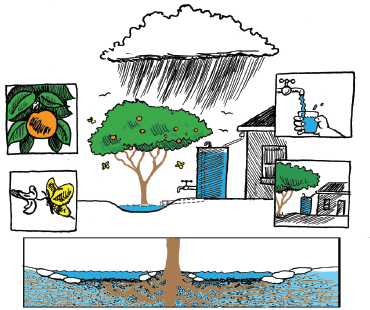
Fig. 1.19. A water-harvesting system providing multiple functions of water, passive cooling with shade, stormwater control within earthworks and cistern, wildlife habitat, and food production
Often, existing strategies designed to perform one primary function can be adapted to perform additional functions. For example, the government’s drainage swales were originally designed only to reduce erosion and flooding, which they did, but they also drained away the area’s sole source of water—an irreplaceable resource. Mr. Phiri added fruition pits to harvest water within the swales and lined his fruition pits with multi-use plants, creating windbreaks, stabilizing the pits, and generating self-seeding crops that flourish on passively harvested water.
Each site has its own unique potential for stacking functions. For example, when designing rainwater cisterns into a site, they can double as privacy walls, pillars supporting porches, property fences, retaining walls, afternoon sunscreens, and more. Get the Domino Theory working for you. You know you’re doing well when you devise a strategy to solve one problem that simultaneously solves many other problems and creates more resources.
RAINWATER-HARVESTING PRINCIPLE EIGHT
Continually Reassess Your System: The “Feedback Loop”
Continual reassessment is the key to long-term maintenance of a water-harvesting system (fig. 1.20).
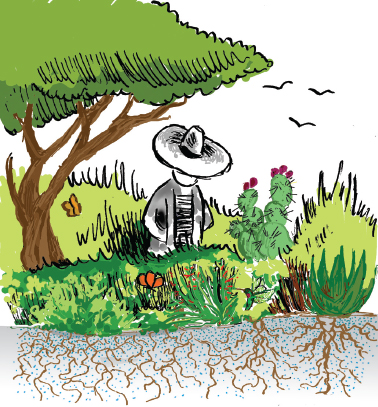
Fig. 1.20. Long and thoughtful observation again. How is the land responding to your work? What still needs to be addressed?
Mr. Phiri had a great idea: Grow water-harvesting structures by placing plants on contour. He “stacked functions” by seeking out plant species that produced crops as they harvested water and reduced erosion. He quickly settled on hardy sisal plants (Agave spp.) that use little water, require almost no maintenance, produce large amounts of biomass to hold back water and soil, and produced fiber to use on site or sell.
Mr. Phiri thought long and hard about this strategy. He began high in his watershed where the sisal contour berms helped spread runoff and infiltrate it into the soil. He built rock-stabilized spillways for overflow. His system quickly maximized groundcover, harvested water, stabilized soil, and produced sisal fibers. The only thing he forgot to do was to start small.
Sisal plants covered his land and slowed runoff. Everything was great until winter arrived in a drought year. Grass was sparse, and plants appeared yellow and dead in their dormancy, but the evergreen sisal stood out verdant and lush: Mr Phiri’s livestock went right for it. The long, strong fibers of the plants bound up in the intestines of the animals, killing them. Mr. Phiri was devastated. He had not foreseen these consequences. There are always consequences that we cannot or do not predict. Mr. Phiri subsequently spent many hard days removing all but one small stand of sisal. He left this stand as a reminder and teacher—and keeps the livestock away from it (fig. 1.21).
Fig. 1.21. Mr. Phiri beside his remaining stand of sisal planted on contour
Following all the principles together can decrease your mistakes and increase your chances of success. No matter how good a plan or design is, maintenance and adaptation will be required over time. When the design is well thought out in the first place, these changes are likely to be minor. Mr. Phiri finds himself reinforcing spillways, maintaining berms and swales, and pruning vegetation for livestock forage and mulch. Sometimes, as with the sisal, he needs to change or alter some of his strategies. After the sisal mistake, Mr. Phiri did not abandon his idea of planting vegetation as water-harvesting structures—he was just more careful about plant selection. Now he starts with smaller plantings to see their effects before he expands to larger areas.
As with Mr. Phiri’s site, all landscapes are continually evolving and we need to continually work with them. Go back frequently and observe how your site is performing, repair elements if needed, and see if there are ways you could improve on your site plan and techniques. We cannot escape the need for maintenance, but we can reduce the need for excessive maintenance by following the eight water-harvesting principles. Balanced maintenance should not be feared or neglected; it is an opportunity to learn and to improve.
WATER-HARVESTING ETHICS
Mr. Phiri’s site and life provide a wonderful example of embodying water-harvesting principles within an integrated system. They also embody an ethical basis that further increases the benefits of his work. The three ethics of permaculture9 described below are realized in Mr. Phiri’s work, and are important guides to me in making decisions about water-harvesting and integrated-system design.
1. The CARE OF THE EARTH10 ethic reminds us to care for all things living and nonliving, including soil, water, air, plants, animals, and entire ecosystems. As Bill Mollison states in An Introduction to Permaculture, “It implies harmless and rehabilitive activities, active conservation, ethical and frugal use of resources, and ‘right livelihood’ (working for useful and beneficial systems).”11
2. CARE OF PEOPLE12 directs us to strive to meet our basic needs for air, water, food, shelter, education, fulfilling employment, and amiable human contact in ways that do not hamper or prevent others from doing the same. We do not exploit or disregard others for our own gain. Nor do we destroy the environment that supports us all. Instead, we sustain a basic quality of life that improves our environment while enabling others to do the same.
3. REINVESTMENT OF SURPLUS TIME, MONEY, AND ENERGY13 to achieve the aims of earth and people care encourages us to extend our influence and surplus energies to help others attain the ethics in their own life and work. This helps us all because it strengthens the greater communities in which we all live.
Mr. Phiri embodies these ethics: He improves his land, the earth, and his community by working with local resources so his land and community can sustainably regenerate more resources. He eschews synthetic fertilizers and clear-cutting that provide short-term gains but pollute and weaken the land in the long run. He practices infusion rather than extraction. He gives his land more than he takes—in the form of water. He gives his community more than he takes—in the form of information, trees, and water. He empowers others to do the same. The Zvishavane Water Project was formed by Mr. Phiri to contribute surplus time, energy, and money to spread these ideas. He teaches people how to harvest rain, improve soil, grow food, and build community. And he learned it all from living it.
By following these eight principles and the “care” ethics above, you can thoughtfully and effectively practice water harvesting and create the best techniques and strategies for your unique situation. Use the principles and ethics as a checklist of guidelines while you assess your site, imagine what water-harvesting strategies would work best and where, and as you implement your ideas. As long as all the guidelines are met you’ll be on the path to abundance.
You now have the tools to conceptualize and plan an integrated rainwater-harvesting system. Read on to find out how much rain you have to harvest.
Box 1.6. Additional Permaculture Resources
I invite you to look into permaculture as a tool to improve your rainwater harvesting efforts, and to integrate sustainable strategies into your life. While I offer a set of principles geared specifically to water harvesting, permaculture literature provides principles that apply to all aspects of our surroundings. I encourage you to pursue this exciting and empowering material. See the permaculture section of the resource appendix at HarvestingRainwater.com
2013 UPDATE ON MR. ZEPHANIAH PHIRI
Many thanks to Ken Wilson, Executive Director of the Christensen Fund, a longtime ally and supporter of Mr. Phiri, for his writings and reports from which most of this update was produced.
Mr. Phiri’s efforts and all he brings to life continue to evolve and grow. He is now 85 years old and his first wife—and co-generator of his farm— Magrate, has passed away, Yet, though Mr. Phiri says he’s “down to one eye and one ear” and his “days are numbered,” he has no sense that his work is finished.
Mr. Phiri is joined in his work by some of his children (his youngest daughter just graduated from college), grandchildren, and in particular his second wife and master farmer/demonstrator/leader, Constance. Together they keep increasing the fertile organic matter in their soil, the diversity of life growing from that soil, and the water they plant within it—all of which increases their ability to cope with drought and floods. The diversity of multi-use, woody plants on the farm has increased 25% since 1999. And new innovations such as gently-sloping diversion swales now direct water from areas of their land that were too wet to those that would otherwise be too dry.
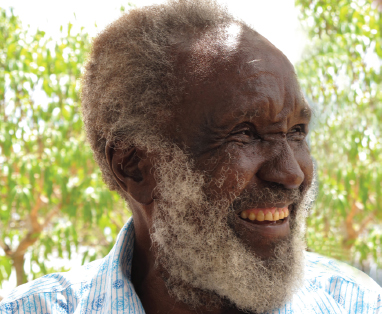
Fig. 1.22. Mr. Zephaniah Phiri Maseko in 2013. Credit: Brock Dolman

Fig. 1.23. Constance and grandchild in 2013. Credit: Brock Dolman
In this hot, dry region of Zimbabwe water arrives rapidly and leaves rapidly. And it doesn’t leave alone. Mr. Phiri explains the situation and his response as follows. “When there are thunderstorms, soil and water try to elope together and run away from my land. It is my job to persuade them to settle down here and raise a family.”
Settle down and raise a family they have, which over the decades has attracted over 8,000 visitors to Mr. Phiri’s farm to see how this common-sense approach has led to ever-increasing productivity and sustainable resilience. Guests have come from over 14 African countries, and 9 other countries in Asia, Europe, and North and South America. However, most important perhaps are the many hundreds of farmers who came by themselves or with local non-government organization (NGO) staff, agricultural extension officers, and other government officials.
This has helped lead to the widespread adoption of the kinds of water-soil management systems that Mr. Phiri, his family, and those who have been inspired by them, have shared with their communities in southern Africa. Tens of thousands of farmers are now taking up these methods across Zimbabwe. According to a 2010/2011 study in Mazvihwa, an area about 62 miles (100 km) from the Phiri home, people have heard this message and taken it to heart, and almost all households are now involved in some form of water harvesting.
Until the last decade most farmers were focused on exploring “modernization” approaches to agriculture—believing hybrid plant varieties, synthetic fertilizer inputs, and extractive water and plant systems from the outside world would make the difference. What Mr. Phiri recommended offered no technological miracle and involved no handout. Instead it relied on farmers developing their own knowledge and investing their own labor to dig and shape their lands to manage water and soil over the long term. Rather poignantly, a large number of men suffering from HIV-AIDS dug water-harvesting earthworks as investments to help their families, even as they slowly died of the disease. These strategies tackled the real constraints of this arid region: the water available for crops. More people came around as the first generation of followers achieved success while external solutions failed to transform the land. This pattern is now seen across the country, with whole communities shifting their farming systems towards water harvesting. Such can be the impact spearheaded by one dedicated, visionary man, and those who have supported him and furthered this work.
Yet Mr. Phiri does not see his approach as a silver bullet, but as a set of principles for approaching soil and water with curiosity, respect and innovation. Copying his practices exactly doesn’t work because every place is unique. He’s delighted to see so many of his followers doing things differently in order to work with the characteristics of their own land.
Likening himself to a bullfrog, Mr. Phiri says he is constantly croaking about the delights of harvesting local waters. For nine years he did so through his NGO, the Zvishavane Water Project (ZWP). In 1996 he retired from the ZWP, and gave the organization a “natural endowment” by granting a portion of his land to train staff, generate income from crops, and serve as a demonstration plot. Mr. Phiri was selected in 1997 as an Ashoka fellow, and in 2006 he received the National Geographic/Buffet Award for Leadership in African Conservation. While receiving a Lifetime Achievement Award at the University of Zimbabwe in 2010, Mr. Phiri invited the researchers at the college to work with him and document what he’s done for the hydrology of his land, its soils, its agricultural productivity, and its biodiversity. He offered to share with them “all the results of forty years of experimentation, except those that I have already eaten.” The offer was eagerly accepted.
Mr. Phiri passed away in September 2015.
Search “Mr. Phiri” at HarvestingRainwater.com for more rememberences, evolutions of his farm and work, and how his family and community are carrying on his legacy.